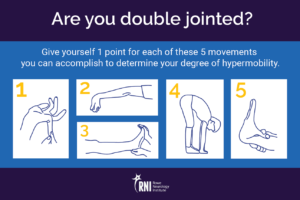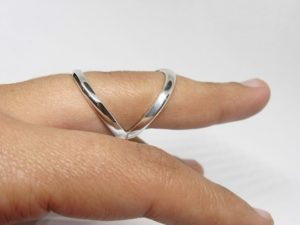When we are born we all have a high degree of flexibility in our joints, as infants need to be able to bend into all sorts of positions. As we age, this flexibility decreases and our joints become much stiffer. This is due to our ligaments maturing and becoming firmer and stronger, resulting in our joints becoming more stable and being able to tolerate higher loads. For some people, their ligaments naturally don’t tighten as much as others, and this results in some adults having joints that retain a higher degree of flexibility, or hypermobility.
Ligaments are the soft tissue structures that connect our joints together and prevent excessive movement. We all know someone who claims to be “double-jointed” – they may be able to touch their thumb to their wrist or have elbows that appear to bend backwards. The truth is these people are hypermobile – their ligaments that support their joints are looser than others, and these looser ligaments allow their joints to move through a greater plane of movement, giving a higher degree of flexibility than what would be considered standard.
Some people only have certain areas of their body that may be more hypermobile than usual. Others may be hypermobile throughout their whole body. This can be the case for people with a condition called Ehlers-Danlos Syndrome (EDS). EDS affects the connective tissue throughout a person’s body and increases the elasticity of their structures, resulting in hypermobility among other things. People who are hypermobile or have an underlying hypermobility condition can usually do one or more of the following things easily:
- Pull the little finger back and hyperextend beyond 90 degrees
- Hyperextend the elbow beyond 10 degrees
- Hyperextend the knee beyond 10 degrees
- Touch both hands flat to the floor while bending at the hips and keeping the knees straight
- Pull the thumb down to touch the forearm

Although being extra flexible may seem beneficial, it can have repercussions on function of a joint. With a higher degree of movement comes less stability in a joint. The stability of a joint refers to a joint’s capacity for staying in the correct position while tolerating loads, therefore a joint with poor stability is more likely to dislocate out of position than a joint that has a higher degree of stability. Our ligaments are the structures that prevent a joint from dislocating, and so having looser ligaments increases the likelihood of a joint popping out of position.
Our muscles also play a role in supporting joints, and are the secondary stabilisers of our joints. Together, our ligaments and muscles work together to support our joints by keeping them in the correct position, assisting them to move through planes of movement and tolerate loads. When someone has ligaments that are looser and not providing as much support, their muscles are required to pick up the slack and work harder to bridge this deficit. As a result, people who are hypermobile are more prone to developing myofascial pain conditions due to the excessive demands placed on their muscles.
For people who are hypermobile, if they lack this adequate muscular support to their joints they can begin to experience pain, inflammation and dysfunction in certain areas of their body due to the poor stability of their joints. In hand therapy, we see this particularly with regards to wrist and thumb function. Our wrist is a complex area made up of many joints that require strong stability to tolerate the everyday loads we place through them. The base of the thumb (the carpometacarpal (CMC) joint) is a joint that is generally less stable as it allows a high degree of movement to facilitate our hand function, and can be an area of concern for people with hypermobility. We rely on the base of our thumb to tolerate high loads which enables pinching and grasping, and people who are hypermobile tend to experience pain and inflammation in this area when they lack the adequate muscular support for this.
 As hand therapists, we are skilled in recognising when patients are hypermobile and have a thorough understanding of the implications of this on a person’s body function. We work closely with our patients to improve joint stability through targeted strengthening and conditioning. Occasionally people who are hypermobile require additional support, such as customised splints, that block hyperextended movements to facilitate their function.
As hand therapists, we are skilled in recognising when patients are hypermobile and have a thorough understanding of the implications of this on a person’s body function. We work closely with our patients to improve joint stability through targeted strengthening and conditioning. Occasionally people who are hypermobile require additional support, such as customised splints, that block hyperextended movements to facilitate their function.
If you have concerns regarding hypermobility or joint pain, you can make an appointment to see one of our skilled therapists for a consultation by calling our friendly reception team or booking online.
